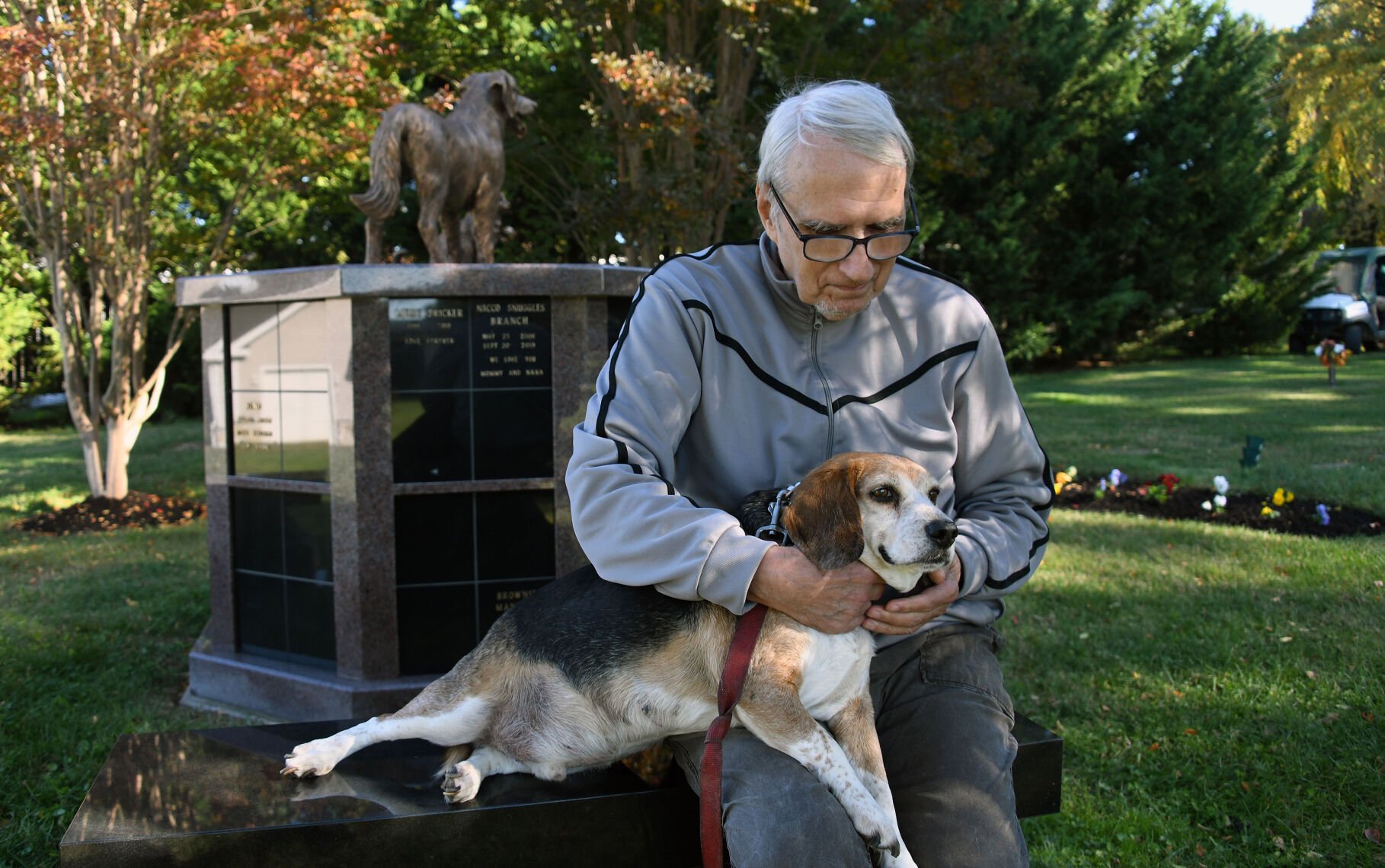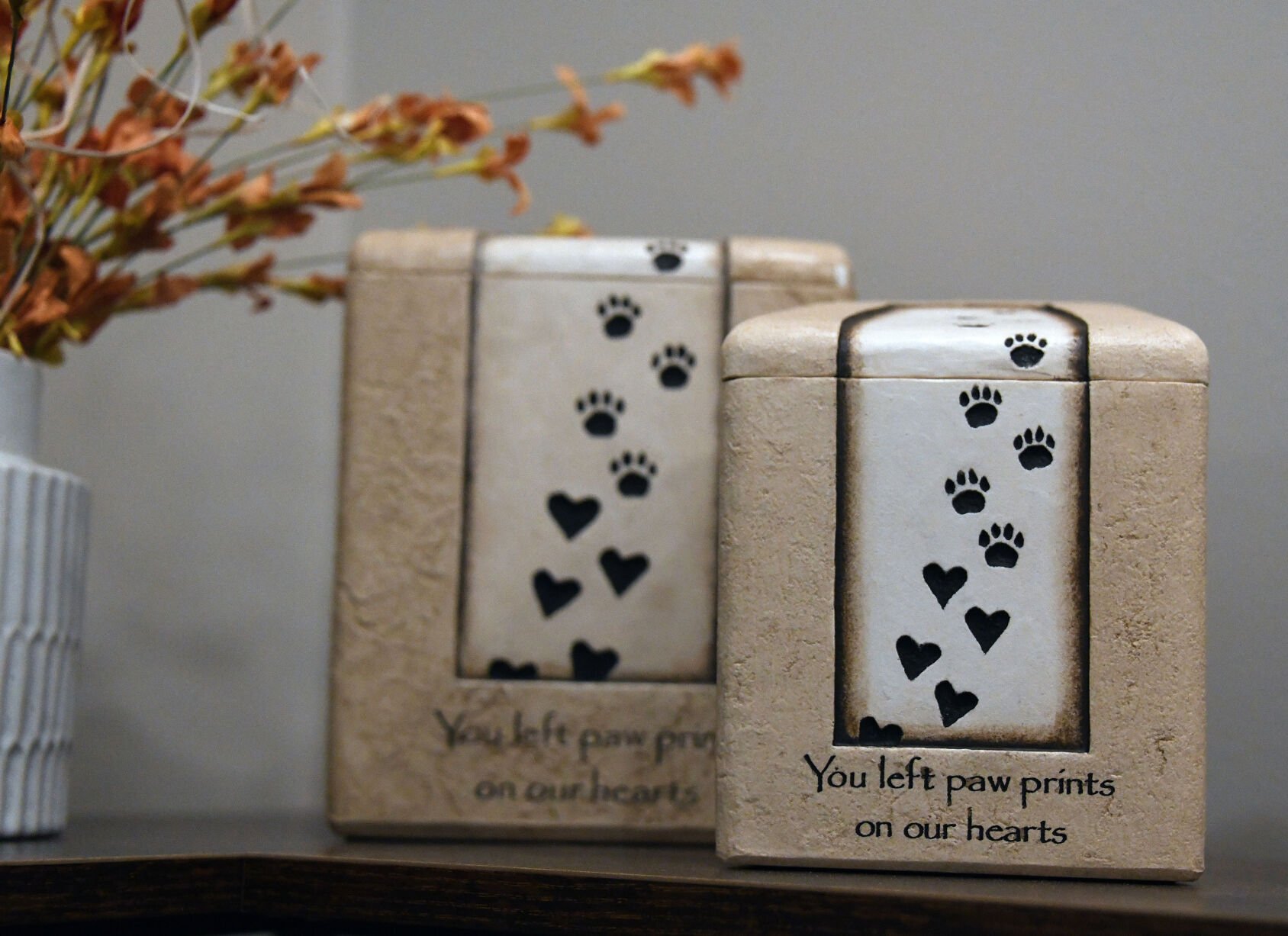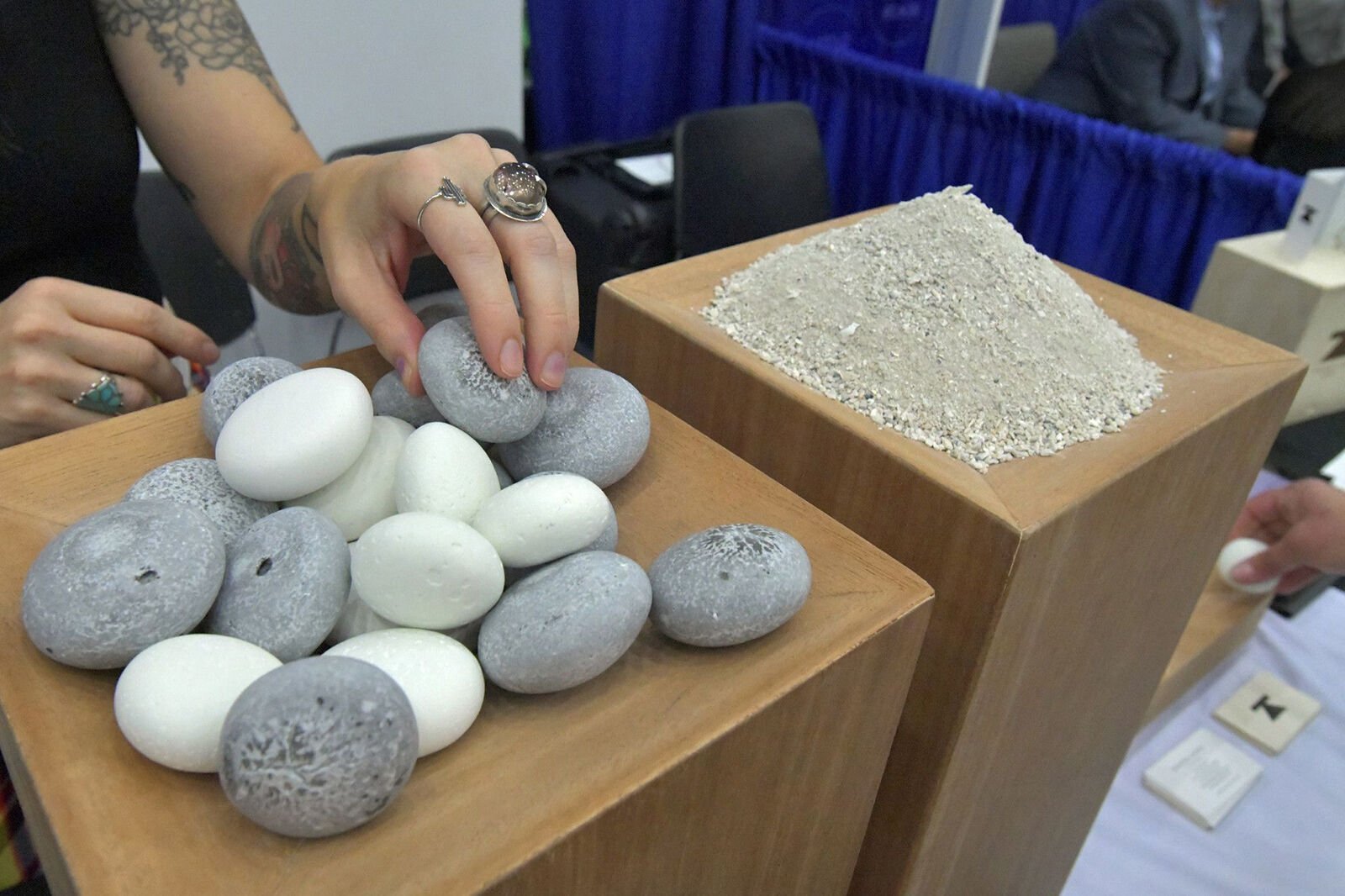BALTIMORE — When Richard Thompson’s wife of 40 years was nearing the end of her life at a Baltimore County hospital, he couldn’t fathom living alone. His two beagles had died unexpectedly earlier this year, but a new rescue beagle named Tucker was the godsend he needed.
Thompson, 73, of Baltimore, adopted Tucker from Beagle Rescue of Southern Maryland in May. The beagle has been a confidant for the retired school teacher since his wife died in June.
“This dog was a miracle because he was there. He loved to be with us. He’s such a sweet dog,” Thompson said. “I put him up on her bed. She met him. She said, ‘You made a good choice.'”

Kim Hairston/The Baltimore Sun
Richard Thompson and Tucker, his beagle, in the Dulaney Valley Memorial Gardens Pet Sanctuary in Maryland. Thompson has had several beagle family members and lost two of them recently. J.J. and Bailey are laid to rest in the pet sanctuary with the marker: “They asked for so little, but gave so much.”
For people like Thompson, pet parenting is sacred. Their animals are much-loved family members who provide support across many stages of life — and as ownership grows and the roles of pets evolve, so does demand for their death care.
The 5-year-old heavyset beagle appeared tuckered out as he waddled into the Dulaney Valley Pet Loss Center, a new pet funeral home that opened in September. The pair came to check out Dulaney because Thompson plans to use it for Tucker one day.
If it’s good enough for humans
The pet death care business is growing exponentially, in proportion to what’s happening with pet ownership and pet expenditures, said Coleen Ellis, who was hired by Dulaney Valley Memorial Gardens as a consultant for the pet loss center.
“I think the need has always been there,” but pet parents have pushed for it more lately, she said. “I think this is the one area that was probably lacking for all these years.”
Ellis, who lives in Texas, is an expert on pet loss and trends. She opened the first standalone pet funeral home in the U.S. in Indianapolis in 2004. It provides the experiential parts of a funeral without a cemetery or a crematory, she said.
People who consider themselves pet parents, as opposed to pet owners, often believe that if it’s good enough for people, then it’s absolutely perfect for pets, Ellis said.
“I think it’s gotten to a point where a lot of people have said, ‘I did all these things while they were alive. I want to make sure their final moments here, their final walk is exactly like they lived — memorable, beautiful, special and unique, just like they were,” she said.
A growing pet industry
The national pet industry exceeded $123.6 billion in sales last year, the highest in history, according to the American Pet Products Association, a trade association serving the interests of the pet products industry.
This was the second consecutive record-setting year for the industry, following a banner year in 2020, which for the first time exceeded $100 billion in sales, according to the APPA. There were spending increases in every category including death care and grief supplies.
Purchasing something to memorialize a pet upon its death is something more pet owners say they plan to do, according to the APPA National Pet Owners Survey. The APPA reported, for example, that 52% of dog owners in 2018 said they would purchase something upon the death of their pet, while 2020 saw 61% and, for cat owners, 42% to 57% for the same years.
The 2020 survey showed that most people would buy an urn for ashes or a memorial stone for the home or yard and caskets. Just under 10% of pet owners say they would purchase memorial jewelry upon the death of their pet.

Kim Hairston/The Baltimore Sun
Stone urns are on display at the Dulaney Valley Pet Loss Center at Dulaney Valley Memorial Gardens in Maryland.
The percentage of U.S. homes with pets reached an estimated 70% in 2022, according to the APPA. Ellis attributes an increase in pet ownership to millennials and baby boomers with their “empty nest syndromes,” referring to the grief parents sometimes feel when their children move out.
“They weren’t ready to be empty — so they got a pet,” she said. “Then you’ve got the millennials, who waited for a while to have children. And so you’ve got both of those, which represent our largest population demographics in our country. You’ve got both of them who embraced it.”
Changes in pet death care trends
Pet death care options were on full display at the National Funeral Directors Association International Convention & Expo in Baltimore in October.
Although cremation has become more popular in recent decades, there’s now another burial alternative: aquamation. Indiana-based Bio-Response Solutions describes its aquamation services as a more eco-friendly alternative that’s less harsh than flame cremation.
Vice president of research Samantha Sieber said the bones of bats or goldfish, for example, would be destroyed during traditional cremation but can be saved through aquamation.
Aquamation or alkaline hydrolysis uses water, alkaline chemicals, heat and sometimes pressure and agitation to accelerate natural decomposition.
“We thought we’d get the people who are eco-friendly, but we hear personal stories about pets that died in a house fire,” Sieber said. “It’s hugely common because they just can’t imagine a fire cremation after their pet suffered that kind of death.”
Other cases include pets who loved spending time in the water, she said. The cremated remains can then be turned into stones or used in jewelry.

Amy Davis/Baltimore Sun
Alexandra Jo of Parting Stone in Santa Fe, New Mexico, handles solidified ashes that are marketed as an alternative form of remains.
-
What the EU is doing to help Ukraine refugees
Vadim Ghirda
A woman holds a dog while crossing the Irpin River on an improvised path under a bridge as people flee the town of Irpin, Ukraine, Saturday, March 5, 2022. (AP Photo/Vadim Ghirda)
Vadim Ghirda
A woman holds a dog while crossing the Irpin River on an improvised path under a bridge as people flee the town of Irpin, Ukraine, Saturday, March 5, 2022. (AP Photo/Vadim Ghirda)
-
What the EU is doing to help Ukraine refugees
Andreea Alexandru
A refugee who fled the Russian invasion from neighboring Ukraine comforts her dog as they sit in a ballroom converted into a makeshift refugee shelter at a 4-star hotel & spa, in Suceava, Romania, Friday, March 4, 2022.(AP Photo/Andreea Alexandru)
Andreea Alexandru
A refugee who fled the Russian invasion from neighboring Ukraine comforts her dog as they sit in a ballroom converted into a makeshift refugee shelter at a 4-star hotel & spa, in Suceava, Romania, Friday, March 4, 2022.(AP Photo/Andreea Alexandru)
-
-
What the EU is doing to help Ukraine refugees
Andreea Alexandru
A puppy peers his head from a pet carrier after his owner fled the conflict from neighboring Ukraine at the Romanian-Ukrainian border, in Siret, Romania, Sunday, Feb. 27, 2022. (AP Photo/Andreea Alexandru)
Andreea Alexandru
A puppy peers his head from a pet carrier after his owner fled the conflict from neighboring Ukraine at the Romanian-Ukrainian border, in Siret, Romania, Sunday, Feb. 27, 2022. (AP Photo/Andreea Alexandru)
-
What the EU is doing to help Ukraine refugees
Bernat Armangue
A Ukrainian girl pets her cat in her coat inside Lviv railway station, Monday, Feb. 28, 2022, in Lviv, west Ukraine. (AP Photo/Bernat Armangue)
Bernat Armangue
A Ukrainian girl pets her cat in her coat inside Lviv railway station, Monday, Feb. 28, 2022, in Lviv, west Ukraine. (AP Photo/Bernat Armangue)
-
-
What the EU is doing to help Ukraine refugees
Daniel Cole
Julia Lazarets plays with her cat Gabriel, after fleeing Ukraine and arriving at the train station in Przemysl, Poland, Tuesday, March 8, 2022. (AP Photo/Daniel Cole)
Daniel Cole
Julia Lazarets plays with her cat Gabriel, after fleeing Ukraine and arriving at the train station in Przemysl, Poland, Tuesday, March 8, 2022. (AP Photo/Daniel Cole)
-
What the EU is doing to help Ukraine refugees
Visar Kryeziu
Katya holds her two dogs after fleeing from Ukraine, at the border crossing in Medyka, Poland, Wednesday, March 9, 2022. (AP Photo/Visar Kryeziu)
Visar Kryeziu
Katya holds her two dogs after fleeing from Ukraine, at the border crossing in Medyka, Poland, Wednesday, March 9, 2022. (AP Photo/Visar Kryeziu)
-
-
What the EU is doing to help Ukraine refugees
Daniel Cole
A refugee holding her dog sits by the side of the road approaching the border with Poland in Shehyni, Ukraine, Sunday, March 6, 2022. (AP Photo/Daniel Cole)
Daniel Cole
A refugee holding her dog sits by the side of the road approaching the border with Poland in Shehyni, Ukraine, Sunday, March 6, 2022. (AP Photo/Daniel Cole)
-
What the EU is doing to help Ukraine refugees
Vadim Ghirda
Ukrainian servicemen help a woman carrying a small dog across the Irpin River on an improvised path while assisting people fleeing the town of Irpin, Ukraine, Saturday, March 5, 2022. (AP Photo/Vadim Ghirda)
Vadim Ghirda
Ukrainian servicemen help a woman carrying a small dog across the Irpin River on an improvised path while assisting people fleeing the town of Irpin, Ukraine, Saturday, March 5, 2022. (AP Photo/Vadim Ghirda)
-
-
What the EU is doing to help Ukraine refugees
Andreea Alexandru
A refugee holding a small dog gives a sip of tea to a toddler after fleeing the conflict from neighboring Ukraine, as they sit in a bus at the Romanian-Ukrainian border, in Siret, Romania, Friday, March 4, 2022. (AP Photo/Andreea Alexandru)
Andreea Alexandru
A refugee holding a small dog gives a sip of tea to a toddler after fleeing the conflict from neighboring Ukraine, as they sit in a bus at the Romanian-Ukrainian border, in Siret, Romania, Friday, March 4, 2022. (AP Photo/Andreea Alexandru)
-
What the EU is doing to help Ukraine refugees
Vadim Ghirda
A girl comforts a cat before the departure of a Lviv-bound train in Kyiv, Ukraine, Thursday, March 3, 2022. (AP Photo/Vadim Ghirda)
Vadim Ghirda
A girl comforts a cat before the departure of a Lviv-bound train in Kyiv, Ukraine, Thursday, March 3, 2022. (AP Photo/Vadim Ghirda)
-
-
What the EU is doing to help Ukraine refugees
Bernat Armangue
A Ukrainian girl and her cat wait at the platform inside Lviv railway station, Sunday, Feb. 27, 2022, in Lviv, west Ukraine. (AP Photo/Bernat Armangue)
Bernat Armangue
A Ukrainian girl and her cat wait at the platform inside Lviv railway station, Sunday, Feb. 27, 2022, in Lviv, west Ukraine. (AP Photo/Bernat Armangue)
-
What the EU is doing to help Ukraine refugees
Andreea Alexandru
A refugee who fled the Russian invasion from neighboring Ukraine comforts his dog as they sit in a ballroom converted into a makeshift refugee shelter at a 4-star hotel & spa, in Suceava, Romania, Friday, March 4, 2022. (AP Photo/Andreea Alexandru)
Andreea Alexandru
A refugee who fled the Russian invasion from neighboring Ukraine comforts his dog as they sit in a ballroom converted into a makeshift refugee shelter at a 4-star hotel & spa, in Suceava, Romania, Friday, March 4, 2022. (AP Photo/Andreea Alexandru)
-
-
What the EU is doing to help Ukraine refugees
Andreea Alexandru
A dog named Josephine licks a Ukrainian woman reunited with her sister after crossing the border from Ukraine at the Romanian-Ukrainian border, in Siret, Romania, Friday, Feb. 25, 2022. (AP Photo/Andreea Alexandru)
Andreea Alexandru
A dog named Josephine licks a Ukrainian woman reunited with her sister after crossing the border from Ukraine at the Romanian-Ukrainian border, in Siret, Romania, Friday, Feb. 25, 2022. (AP Photo/Andreea Alexandru)
-
What the EU is doing to help Ukraine refugees
Andreea Alexandru
A refugee fleeing the conflict from neighboring Ukraine wipes away tears after seeing a relative at the Romanian-Ukrainian border, in Siret, Romania, Monday, March 7, 2022. (AP Photo/Andreea Alexandru)
Andreea Alexandru
A refugee fleeing the conflict from neighboring Ukraine wipes away tears after seeing a relative at the Romanian-Ukrainian border, in Siret, Romania, Monday, March 7, 2022. (AP Photo/Andreea Alexandru)
-
-
What the EU is doing to help Ukraine refugees
Petr David Josek
A woman from neighboring Ukraine sits with her dog at a train station that was turned into an accommodation center in Przemysl, Poland, on Thursday, Feb. 24, 2022. (AP Photo/Petr David Josek)
Petr David Josek
A woman from neighboring Ukraine sits with her dog at a train station that was turned into an accommodation center in Przemysl, Poland, on Thursday, Feb. 24, 2022. (AP Photo/Petr David Josek)
-
What the EU is doing to help Ukraine refugees
Vadim Ghirda
A couple talks after people rushed to board a Lviv-bound train in Kyiv, Ukraine, Monday, Feb. 28, 2022. (AP Photo/Vadim Ghirda)
Vadim Ghirda
A couple talks after people rushed to board a Lviv-bound train in Kyiv, Ukraine, Monday, Feb. 28, 2022. (AP Photo/Vadim Ghirda)
-
-
What the EU is doing to help Ukraine refugees
Vadim Ghirda
Antonina, 84 years old, sits in a wheelchair after being evacuated along with her 12 dogs from Irpin, at a triage point in Kyiv, Ukraine, Friday, March 11, 2022. A large scale evacuation operation of residents of a satellite area of capital Kyiv continued Friday, with more and more people deciding to leave areas now under Russian control.(AP Photo/Vadim Ghirda)
Vadim Ghirda
Antonina, 84 years old, sits in a wheelchair after being evacuated along with her 12 dogs from Irpin, at a triage point in Kyiv, Ukraine, Friday, March 11, 2022. A large scale evacuation operation of residents of a satellite area of capital Kyiv continued Friday, with more and more people deciding to leave areas now under Russian control.(AP Photo/Vadim Ghirda)



